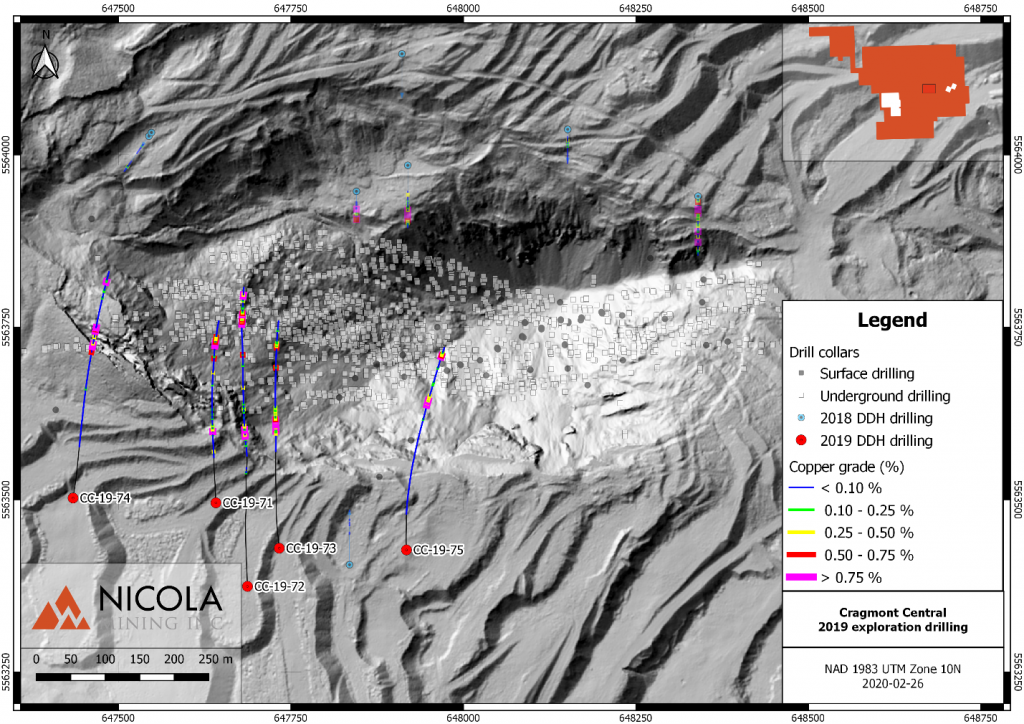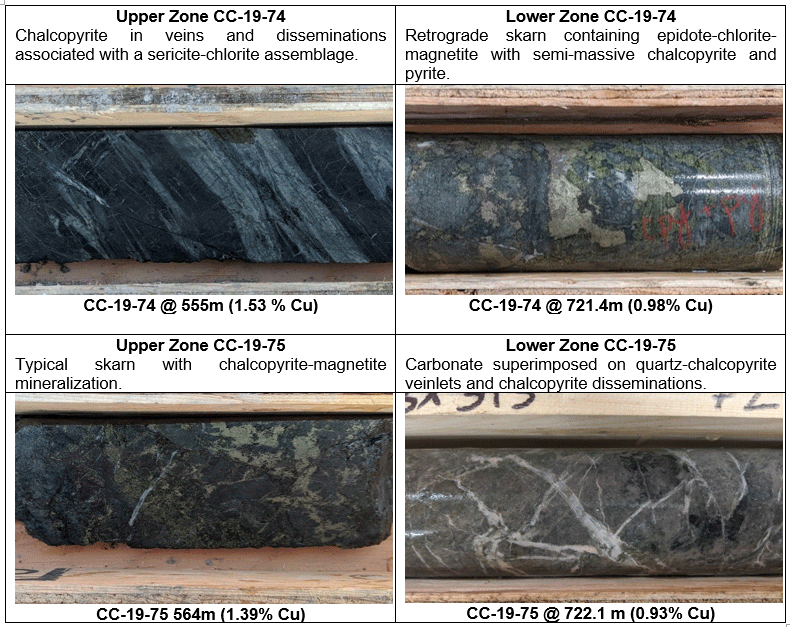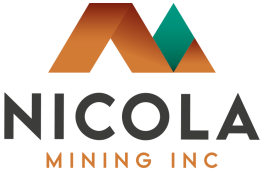Nicola Mining Provides Drill Results For Both Porphyry-Style And Skarn Style Mineralization
TSX.V: NIM
NEWS RELEASE
VANCOUVER, BC, March 23, 2020 – Nicola Mining Inc. (the “Company”) is pleased to report the results of the final two drill holes of the 2019 diamond drill hole program (“2019 Drill Program”). The 2019 Drill Program consisted of five holes at the Company’s wholly-owned New Craigmont Copper Project (“Craigmont Project”), located 14km from the City of Merritt, BC.
The 2019 Drill Program targeted potential mineralization in the southwest margins of the historic Craigmont open pit and historic underground workings. All holes intersected copper mineralization (Figure 1). Additional to mineralized intercepts, the 2019 Drill Program provided insight into a potentially larger mineralized system, as highlighted below:
- Two Styles of Mineralization: Drill holes intersected skarn-type mineralization typical of the historical mine and for the first time, mineralization with porphyry-style characteristics.
- Extension of Mineralization and Alteration: The 2019 Program expanded drill-tested length of the west-trending corridor of copper mineralization to 900 metres.
Figure 1: Map of 2019 exploration drill locations

The first three drill holes of the 2019 Drill Program targeted extensions of the No. 3 Mineralized Body. These holes returned long intercepts of propylitic alteration containing shorter, higher-grade Cu intervals. The final two drill holes were designed to evaluate the alteration corridor along strike of the No. 3 Mineralised Body and below the historic underground workings.
- Drill hole CC-19-74 is located 200m west of CC-19-71 and positioned to test the westward extent of the No. 3 Mineralized Body.
- Drill hole CC-19-75 is located 200m east of CC-19-73 and below Portal 2400. It was drilled to 751.33 m and positioned to evaluate the continuation of the Upper Zone encountered in drill holes CC-19-71, 72 and 73.
Table 1: Drill Hole highlights of CC-19-74 and CC-19-75
|
Hole ID (Easting, Northing, Azimuth, Dip) |
Interval width (from – to) | Cu (%) | Zone |
|
CC-19-74 (647434, 5563502, 009°, -63.9°) Includes | 19.25m (547.00 – 566.25m) 7.37m (552.78 – 560.15m) |
0.7 1.39 | Upper Zone Porphyry-style |
| CC-19-74 |
9.00m (720.50 – 729.50m) | 0.31 | Skarn zone |
|
CC-19-75 (647918, 5563427, 011°, -66.4°) Includes |
34.00m (548.00 – 582.00m) 12.50m (554.00 – 566.50m) |
0.38 0.55 | Upper Zone Skarn-style |
| CC-19-75 |
14.00m (719.50 – 733.50m) | 0.51 | Lower Zone Porphyry-style |
CC-19-74 intersected two distinct mineralisation styles (Figure 2). The upper zone mineralization is dominated by fracture-controlled chalcopyrite veinlets associated with sericite-chlorite alteration. Cu grades are related to the abundance of these veinlets. This zone is interpreted to be the westward continuation of the No. 3 mineralized body. The deeper zone is comprised of semi-massive chalcopyrite ± magnetite in a skarn mineral assemblage. This deeper zone is beyond the limits of previously exploited mineralized bodies.
CC-19-75 intersected two mineralized intervals (Figure 2). The upper zone is dominated by retrograde skarn assemblage associated with chalcopyrite ± magnetite mineralization. The lower zone contains quartz – chalcopyrite veinlets and disseminated sulfide more typical of porphyry style mineralization (Figure 2). This lower zone is located 180m below the 2400’ level, which are the deepest underground workings.
The retrograde skarn alteration associated with chalcopyrite ± magnetite/hematite was the focus of mining activities from 1962-1981 and is well-documented in the Craigmont Mine literature. The historic No. 3 Mineralized Body and more recent drilling completed by the company encountered veinlet-controlled and disseminated mineralization associated with chlorite-sericite alteration that resembles intermediate argillic alteration described in porphyry deposits worldwide.
Figure 2: Examples of copper mineralization styles encountered in CC-19-74 and CC-19-75.

Further work based on results of recently completed drilling will involve:
1. Continued compilation of historical mine information to delineate critical alteration zones.
2. Undertake petrography to support alteration mapping.
3. Refine a geological model incorporating information from recent drilling.
Future exploration will be planned to explore the mineralization corridor hosting the historic Craigmont Mine mineralization and test the hypothesis for a porphyry centre associated with Craigmont skarn mineralization. In addition, other Cu prospects on the New Craigmont property will be evaluated and advanced.
The Company also announces that it has issued 1,350,000 Incentive Options at $0.12, expiring on January 20, 2025 to key management, directors and service providers. The Company has a policy to issue up to 5% in Incentive Options.
Scientific and Technical Information
All information of a scientific or technical nature contained in this document, has been reviewed and approved by Kevin Wells, P. Geo., a consulting Geologist to Nicola Mining. Wells is a Qualified Person as defined by National Instrument 43-101 – Standards of Disclosure for Mineral Projects.
About Nicola Mining
Nicola Mining Inc. is a junior mining company listed on the TSX Venture Exchange and is in the process of recommencing mill feed processing operations at its 100% owned state-of-the-art mill and tailings facility, located near Merritt, British Columbia. It has already signed four mill profit share agreements with high grade gold producers. The fully-permitted mill can process both gold and silver mill feed via gravity and flotation processes. The Company also owns 100% of Treasure Mountain, a high-grade silver property, and an active gravel pit that is located adjacent to its milling operations.
About New Craigmont Property
In November of 2015, Nicola became the first group in decades to consolidate ownership of the New Craigmont Project (the “Property”) and has been actively conducting mineral exploration since. The Property is a wholly-owned copper property with an active mine permit (M-68), located 33 km south of the world-class Highland Valley porphyry district. It lies at the southern contact between the Nicola Group rocks and Guichon Creek batholith, of which the latter is known to be a precursor to mineralization at Highland Valley. For further details on the Property, see the technical report entitled “Technical Report on the Thule Copper– Iron Property, Southern British Columbia, Canada”, filed on May 8, 2013 on Sedar at www.sedar.com.
On behalf of the Board of Directors
“Peter Espig”
Peter Espig
CEO & Director
For additional information
Contact:
Peter Espig
Phone: (778) 385-1213
Email: info@nicolamining.com
Neither the TSX Venture Exchange nor its Regulation Services Provider (as that term is defined in the policies of the TSX Venture Exchange) accepts responsibility for the adequacy or accuracy of this release.
